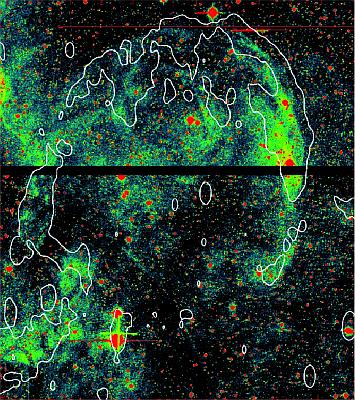 | |||
|
| Home > Public Information > Scientific Highlights > 2005 > A Jet-Powered Bubble Formed in the Gas Around Black Hole Cygnus X-1 |
|
A Jet-Powered Bubble Formed in the Gas Around Black Hole Cygnus X-1
INT+WFC
Galactic black holes undergoing accretion are thought to emit the bulk of their power in the X-ray band by releasing the gravitational potential energy of the infalling matter.
At the same time, they are capable of producing highly collimated jets of energy and particles flowing out of the system with relativistic velocities that travel into the surrounding medium. Black Hole X-ray Binaries (BHXBs) are the essential laboratories for understanding the overall physics of the accretion process in these systems, and have provided us with a wealth of understanding of, for example, the properties of the accretion disc. In comparison, the energy and matter content of the jets produced by BHXBs are not well constrained because they are radiatively inefficient. Relativistics jets are a common feature of accreting black holes on all mass scales, ranging from supermassive black holes at the centres of active galactic nuclei to stellar-mass black holes in X-ray binary systems within our own Galaxy. Whereas the inflow of hot gas can be very efficient in producing light (up to 40% of the accreted material may be transformed into energy and radiated away in the form of optical/ultraviolet/X-ray photons), the same is not true for the synchroton-emitting outflow, whose efficiency might be lower than a few per cent. Estimating the total -radiated plus kinetic- power content of the jets, and hence their importance with respect to the accretion process in terms of energetics, is a primary aim of high energy astrophysics. Attempts at measuring the jet power from radio luminosities are riddled with assumptions about its spectrum and radiative efficiency. However, the jet power can also be constrained by analysing its interaction with the surrounding interstellar medium (ISM). Synchrotron radio lobes associated with jets from AGN are commonly used as accurate calorimeters of the power×lifetime product of the jets, a method only very recently applied to jets from stellar mass black holes. In 2004, very deep low radio frequency observations of the field of Cyg X–1, a 10-solar-mass black hole, resulted in the discovery of a shell-like structure which is aligned with the resolved radio jet of this BHXB. This radio shell has been interpreted as the result of a strong shock that develops at the location where the collimated jet impacts on the ambient ISM. Models of jet-ISM interactions predict a shell of shocked compressed ISM visible via bremsstrahlung emission, containing a bubble of relativistic synchrotron-emitting plasma. The spectrum of the shocked shell should be approximately flat from radio to much higher frequencies and possess spectral lines in emission. To test this, the Cyg X–1 jet-blown nebula was consequently observed at optical wavelengths with the Wide Field Camera of the Isaac Newton Telescope.
The shell of the nebula is clearly visible in a 100-minute Hα image (a lower limit of m≤23.1 arcsec–2 from the nebula was calculated from the observations).
The researchers claim that an emission mechanism with a flat spectrum, such as bremsstrahlung, plus excess flux possibly due to line emission, as expected in the case of radiative shock, can explain the radio and optical data obtained. However, the spectrum is inconsistent with that of optically thin synchrotron radiation. This, therefore, is the
first detection of a thermal shell of gas that is shocked by its interaction with a jet of a Galactic black hole.
The discovery of this large-scale (~5 parcsecs in diameter) ring-like structure surrounding Cygnus X-1 that appears to be inflated by the inner radio jet imply that low-luminosity stellar-mass black holes as a whole dissipate the bulk of the liberated accretion power in the form of "dark", radiatively inefficient relativistic outflows, rather than locally in the X-ray-emitting inflow, whose key signature is the eventual energization of the ambient medium. So for decades astronomers have been severely underestimating how much power black holes pump back into the universe instead of merely swallowing material across their event horizons. The discovery team has ruled out the possibility that the ring might be the low-luminosity remnant of the supernova that spawned the black hole. Since Cygnus X-1 moves in the sky along a trajectory that is roughly perpendicular to the jet, it cannot possibly have been located in the centre of the ring. This profitable technique has potential for constraining the jet power associated with other BHXBs if further jet-blown nebulae are identified. With the confirmation of this jet-ISM interaction associated with Cyg X–1, it is clear not only that there may be an undiscovered population of jet-blown bremsstrahlung nebulae associated with BHXBs, but also that these nebulae may easily be found with simple wide-field red-optical imaging.
References:
|
| Top | Back |
|


